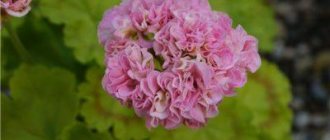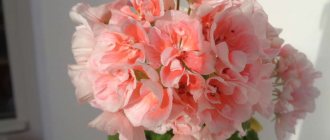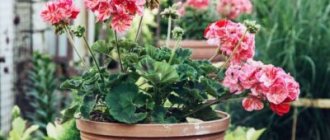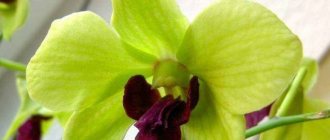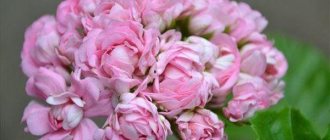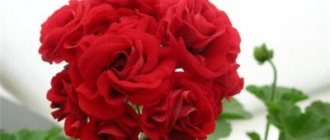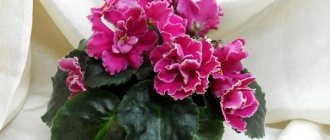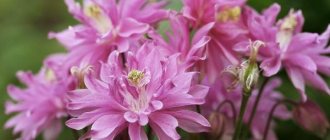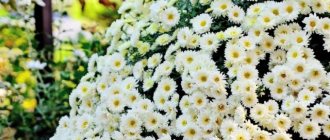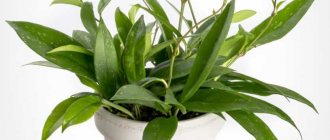History of origin
Initially, India was considered the birthplace of pelargonium, but this statement was erroneous. And all because it was delivered on European ships that sailed to the shores of India. As it turns out, South Africa is the true place where pelargonium grows . There, at the Cape of Good Hope, sailors bought exotic plants for breeders and botanists. 80% of the known pelargonium species were found in this part of the world.
In 1951, an association of amateurs and breeders called the British Pelargonium and Geranium Society was created in England, under the leadership of John Cross. Thanks to this, a new wave of popularity for pelargoniums began, and interest in marvelous flowers was revived, which continues today.
Reference. More than 100 million plants are grown and sold worldwide each year.
Appearance and varieties
Pelargonium is a perennial herbaceous or subshrub plant. The inflorescences have an irregular shape. Petals are white, pink, and shades of red.
The fruit is a seed capsule with sepals. The foliage is green, covered with small fibers. The leaves have a pleasant smell.
Experts in the field of botany count over 250 varieties of pelargonium, which are divided into 30 groups. Main groups :
- zonal;
- ivy-leaved;
- fragrant;
- royal;
- angels;
- unique.
Greenhouse farms in Great Britain, Belgium, Holland, and Russia are engaged in the selection of pelargonium. I would like to highlight the domestic amateur breeder Yulia Gonchar. She has the following varieties :
- Pelargonium South-Aksinya.
- South Alexandra.
- South Anisa.
- South-Giselle.
- South Yesenia.
- South Deya.
- South-Tamil.
- South Ireland.
- South Siberia.
- Yug-Eter and others.
Main characteristics
Let's look at the key features of Damask roses in the table:
| Parameter | Characteristic |
| Family | Roses (Rosaceae)/Rosaceae |
| Genus | Rosehip (Rosa) |
| View | Damask rose (Rósa×damascena)/Damask (D) |
| Garden group | Old Garden Roses |
| Form | Bush |
| Life cycle | perennial |
| Purpose | Industrial, decorative |
| Dimensions of the bush (height / width) | 80-200 cm / 50-120 cm |
| Flowering type | Single (some varieties are re-blooming) |
| Flowering period | June – July (certain varieties – until late autumn) |
| Type of flower | Semi- and dense double |
| Number of petals | 25-40 pcs. |
| Flower diameter | 6-10 cm |
| Petal coloring | Varied: from white-pink to red |
| Disease resistance | Average |
| Frost resistance | Up to −17… −20 ℃ |
Description and photos of species of Yu. Gonchar’s own selection
Below is a detailed description and photo of the varieties Shukar, Varvara Krasa, Nina, Kamalia.
Nina
Plants of the species are zonal, dwarf in size . Flowers with densely double petals, pale pink with a soft purple tint. A lush compact bush easily forms on its own. The stem and peduncles are dense, fleshy, directed upward. The inflorescences are shaped like roses. The foliage color is golden with a brown edge.
This variety of pelargonium got its name in honor of grandmother Yulia Gonchar. The price of a rooted cutting is 1000-1500 rubles.
Shukar
This species also belongs to the zonal species. Standard size, requires shaping. Inflorescences are scattered in different directions. Shades: cherry, scarlet, dark red with tints. The texture of the flowers is semi-double and simple, large in size. The shape of the petals is slightly elongated. The name "Shukar" translated from the Gypsy language means "beauty" . The price of a rooted cutting varies from 1000-1200 rubles.
Varvara Krasa
An upright zonal plant, dwarf in size. The bush is dense, dense, easy to form, and has regular growth. The flowers are large, double, light pink. In the sun it takes on a deeper pink hue. Pelargonium blooms profusely and for a long time. You can buy rooted cuttings for 500-700 rubles apiece.
Kamalia
Zonal flower, dwarf size. The bush is branched, the foliage is green. The inflorescences have an original shape, slightly shabby. The color is soft pink, gradually turning to rich. The texture of the flowers is terry. The variety is distinguished by long-lasting flowering, even in winter. The cost of one cutting is 700-1000 rubles.
How and where to plant?
The container for pelargonium is chosen to have a small diameter. Compact flower bushes will hold their shape better in them; flowering also directly depends on the size of the flowerpot . The plant refuses to bloom in large pots. Material for the container, preferably clay. A drainage layer of at least 2 cm thick is required.
- The plant should be placed in a pot carefully; the root system is fragile.
- Then carefully sprinkle it with earth without compacting it.
- Moisten the top a little with warm, settled water.
Lighting
You need a lot of light. The plant loves sun and bright light. Preference should be given to window sills on the south side. However, if there is poor ventilation, it may overheat, in which case you need to temporarily darken it. With a lack of sunlight, the leaves turn yellow and the lower ones dry out. For an evenly lush crown, the flower must be regularly turned to the sun, first on one side, then on the other.
The soil
For planting and replanting, the soil needs to be loose, breathable, and enriched with minerals. Soil for pelargonium can be purchased ready-made at garden stores . Or cook it yourself.
The composition of this soil mixture is: leaf soil, peat or compost humus, sand. All components must be in equal proportions.
For safety precautions, it is better to ignite the components of the mixture for 30 minutes. You can also add perlite as a soil loosener.
Conditions for growing indoor flowers
Pelargonium is an undemanding indoor flower . However, for a healthy and beautiful appearance, comfortable conditions are important for the plant.
- An indoor flower should be watered abundantly, but at the same time the water should not stagnate in the pot. Watering is needed abundantly, daily, especially in hot weather. In winter, you don’t need to water much, but you should not let the soil dry out completely. If watering is abundant, traces of gray rot appear on the leaves, and sometimes the stem rots, which can lead to the loss of the plant. If you water little, the flower withers, the leaves begin to turn yellow and dry out.
- Air humidity is not particularly important for pelargonium; on the contrary, excess moisture and stagnant air can cause fungal diseases of the flower. Spraying should not be done.
- In the warm season, the optimal temperature is +18 -22 C°. Sufficiently high air temperatures, especially indoors, will also negatively affect the plant.
- In winter, pelargonium is in a state of sleep. Plants should be moved to a room with a temperature of +12°C and regular ventilation. This could be a loggia, balcony, greenhouse. Watering should be sparse. Wintering lasts approximately from November to February. At the end of winter, pelargonium begins to gradually wake up.
- Replanting and pruning. These procedures should be performed annually, preferably in the spring, in mid-March. In order for the plant to have a lush appearance, it is necessary to trim the pieces. Perform this procedure only with a sharp knife diagonally. Broken parts of the plant may be affected by rot. And to enhance growth and branching, shoots are pinched.
- To ensure adequate nutrition, the flower needs to be fed and organic fertilizers applied. But it is important to dose the fertilizer and follow all the instructions indicated on the packaging:
- Feed “Mr. Color” Saintpaulia during or before flowering with 1 capful per 1 liter of water.
- "Gilea" - recommended concentration is 2 caps per 1 liter.
- “Fertimix” vermicompost for flowering plants, 3 caps per 1 liter, apply once every 10-14 days.
Important. Use only clean water at room temperature.
Adding nutrients is prohibited in hot weather. In this case, the plant will suffer stress.
- First, you should move it to a cool place.
- Next, be sure to water the flower, otherwise fertilizers may burn the roots.
Most of all, the plant needs additional nutrition in summer and spring. Therefore, you need to feed until the beginning of September, approximately once every 2 weeks . You should not feed a transplanted or just purchased plant; you need to wait at least 1 month. It is also not recommended to use mineral fertilizers for sick flowers with damaged root systems.
Pelargonium SOUTH Shukar, Aksinya, Ireland and other varieties
SOUTH Shukar pelargonium is one of the popular varieties. The rich burgundy inflorescences are attractive due to their large size. They stand out effectively against the green background.
Description
Russian breeder Yulia Gonchar gave the world many varieties of geranium.
The plant attracts with its rich color
Unlike other varieties, representatives of the YUG group have a compact size and beautiful flowering.
A brief history of the appearance of flowers of the YUG group
India has long been considered the birthplace of pelargoniums, but only recently have scientists been able to establish the exact origin of the plant. It originally appeared in South America.
Active selection began in 1951 in England. Amateurs and experienced flower growers grew new varieties, achieving improved flower characteristics.
Yulia Gonchar (YUG) was no exception. She wanted to get compact geraniums that would have large inflorescences. Over time, the breeder's work was successful, and she created many new plants.
For example, pelargonium SOUTH Aksinya has double inflorescences of a delicate red color with a barely noticeable white center. The small size of the specimens allows them to be kept in apartments and tiny rooms. The dwarf size does not make pelargonium unattractive; on the contrary, at such a height the plants’ inflorescences look impressive.
Varieties
The YUG group currently includes many varieties. They have different colors, and this allows collectors to show interest in new species. The shades of some varieties of pelargonium change during flowering. For example, like YUG Varvara-Kras’s pelargonium.
Geranium variety with double-colored petals
- SOUTH Shukar - rich burgundy color of the petals, size about 50 cm, requires the formation of a crown.
- SOUTH Jadwiga pelargonium - flowers are soft pink, do not require pruning, green leaves. Average height 40 cm.
- SOUTH Sakura - the name comes from the plant of the same name. The center of the flower is crimson, the rest is light pink. The leaves are serrated.
- Pelargonium Varvara-Krasa is a dwarf size, height does not exceed 30 cm. Double flowers are similar in shape to peonies. Color white-pink. Blooms for a long time.
- SOUTH Zlatoslava - Bright pink inflorescences. The leaves are green with a slight tint of gold.
- SOUTH Claudia - snow-white, double flowers, plant size is dwarf, crown formation is not required.
- SOUTH Princess Grace is an original variety. The white petals are edged with a dark pink border.
- Pelargonium SOUTH Ireland - flowers are white, sometimes greenish in the middle and outside of the petals. Does not require the formation of a bush.
- SOUTH Yesenia - pink flowers with reddish veins, the edges of the petals are pinkish-white.
- SOUTH Nina - golden foliage. The flowers are densely double, pale lilac-pink. The bush forms independently.
Pelargonium SOUTH Shukar needs the right conditions. The abundance of flowering and the lifespan of the flower depend on this.
Important! If you deviate from the recommendations, the geranium may stop blooming.
Factors required to grow a flower:
- Illumination is diffused light; during the flowering period, the duration of daylight is at least 8 hours.
- Temperature – in the warm season – 23 °C, in the winter – 15 °C.
- Watering – during the flowering period, the plant is watered once a week, as stagnation of moisture leads to the development of gray rot. In winter, the amount of watering is reduced to once every 10 days. The humidity level is maintained at 60%. SOUTH Segal pelargonium and others do not need spraying.
- Fertilizing – during flowering, add a universal remedy for flowering plants once a week. The soil should be loose and nutritious.
- The size of the pot is 1 cm larger than the earthen ball.
- Pruning - dwarf varieties do not need to form stems; taller specimens can be pinched out in the spring. Transplantation is carried out once a year.
Features of periods of development
The plant has two periods of time in the year - dormancy and active growth. They must be changed periodically, otherwise the geranium will not live long.
Periods
Growth time is in spring and summer. Around mid-April, pelargonium awakens from hibernation and begins to grow. At this time, bud formation and flowering occur.
This is interesting! Some varieties of geraniums bloom for a very long time (even in winter), for example, YUG Kamalia pelargonium.
In spring, geraniums form buds
Preparation for dormancy begins around September. During this period, the plant is not replanted, fed or rearranged. It is advisable to reduce the temperature, the amount of watering and the length of daylight hours.
Geraniums awaken gradually. To do this, they are gradually returned to their usual conditions of detention, imitating the change of seasons in nature.
Types of flowers
The varieties differ not only in size and color. Pelargonium SOUTH Deya, for example, has double petals - this makes the flowers voluminous, lush, and beautiful. They are called terry.
Varieties may have different flower shapes. For example, in tulip pelargonium they resemble tulips. This also applies to rosebud species. Deacons look especially beautiful. This geranium has flowers collected in a small bouquet.
Reproduction methods
The easiest way to propagate pelargonium is by cuttings. To do this, just cut the stalk, put it in water or plant it in the ground. It takes 2-3 weeks for the roots to germinate, after which the plant needs to be cared for as usual.
Important! During flowering, branches cannot be cut, as the wound will negatively affect the health of the flower.
Additionally, you can use stimulants for the development of the root system, for example, “Kornevin”. It is better to do this in the spring, when the geranium is gaining strength.
Another breeding option is using seeds, which are sold in specialized stores. They are planted in March in shallow containers. The first shoots appear at 3-4 weeks, picking is carried out at 6 weeks after sowing. This method of growing is difficult for indoor conditions.
Diseases and pests
When the soil is over-moistened, gray rot appears, which is easy to visually detect by characteristic spots. The affected parts are removed and the plant is treated with a fungicide.
When the air is dry, rust appears on the leaves of pelargonium. Treatment is the same as for gray rot. The disease can be identified by a characteristic brown coating on the leaves.
When there is a lack of air humidity, the plant is affected by spider mites. Its presence is determined by the characteristic web on geraniums. To kill the pest, the entire plant is sprayed with an insecticide.
Aphids are also easy to see visually. It attaches to the outside of the leaf and stems. Insects are carefully cleaned with a cotton swab, and the geranium is washed with soapy water and treated with an insecticide.
The description of a variety does not always give a complete picture of the characteristics of a particular pelargonium. Carefully study the care recommendations, this will help preserve the plant for many years.
Reproduction methods
Cuttings
At the end of flowering, the tops of the pelargonium are cut off. The top 3 leaves are left, the others are removed.- Sections must be treated with fungicide, ash or activated carbon. This is done so that the stem of the mother plant does not rot.
- Then the cuttings are placed in transparent glasses with drainage, coke fiber or coarse sand is placed in them, and liquid is poured in.
Another option is to place the cuttings in a container with water and, as they dry, it needs to be added.
Roots appear quite quickly, after 10-12 days . The temperature in the room must be maintained at least +20°C. After this, the rooted cuttings are planted in previously prepared soil in a permanent place, where they continue to develop.
Next, you can watch a video that talks about cuttings:
Dividing the bush
If the bush has grown, you can divide it. The best time for this is spring, when the plant is replanted and the soil is renewed.
- First of all, remove the flower from the pot and shake off excess soil.
- Then they carefully examine his kidneys.
- The area with healthy kidneys is separated and transplanted into another container.
Origin
The ornamental garden plant Rosa Damascena has been grown in the Middle East since ancient times. There is also information about its cultivation in the Roman Empire - frescoes with images of the flower have survived to this day. Then the Arab countries became the main place of distribution. According to official data, the plant was reintroduced to Europe in 1875 from Syria. Disputes about the real homeland of this beautiful flower continue to this day.
Damask roses are harvested at the full bloom stage; their petals are a valuable raw material for the production of rose oil.
Previously it was assumed that the flower is a hybrid of Rosa gallica and Rosa canina. Later, DNA analysis of four ancient Damascus varieties showed that they had a common ancestor of hybrid origin, the parent species of which were: (Rosa moschata × Rosa gallica) × Rosa fedschenkoana.
At the moment, there are many varieties of Damask beauty. The most popular varieties: “Kazanlak” (aka Bulgarian or Turkish rose), “Leda”, “Ispahan”, “Marie Hardy”, “Marie Louise”, “Yolanda de Aragon”, “Perpetual White Moss”, “York and Lancaster” ", "Duc de Cambridge", "Quattro Season" and others.
The photo shows a Damask rose of the Duke de Cambridge variety, which is characterized by long flowering and hardiness.
Diseases and harmful insects
Pelargonium is resistant to various diseases and pests . But they still occur:
- Gray mold is a disease that affects leaves. You need to fight it in the following way: remove damaged leaves, stop watering the plant, put it in the sun, spray it with an antifungal agent.
- Rot of the root collar of a flower develops with excess moisture. This phenomenon turns out to be detrimental to pelargonium.
- Rust appears as yellow spots on the bottom of the leaf.
Disease prevention is to treat plants with antifungal solutions before wintering. They are also sprayed with fungicide products, the drug “Doctor Foley” for fungi. The affected parts of the plant must be removed. Among insects, the main pests are whiteflies, aphids, mites, thrips, and mealybugs.
Advice. Before buying a flower, carefully inspect it; you can infect other healthy plants. They are treated with products with insectoacaricidal properties, for example “Doctor Foley” against parasites.
What other famous varieties of pelargonium are there? Read about Richard Hudson, Prince Gustav, April Snow, Star-shaped, Milfeed Rose, Australian Pink Rosebud, Anita, Rococo, Grandiflora, Red Pandora.
Growing pelargonium at home is not at all difficult . Especially if you follow the basic rules for caring for the plant. Then the flower will grow and smell fragrant for joy.
Advantages and disadvantages
The advantage of roses is their large flowers
All varieties of Damask rose have the following advantages:
- they have large (up to 7 cm in diameter) flowers;
- they exude a pleasant, delicate aroma;
- Roses are used to create cosmetics and medicines, and in cooking.
Disadvantages of different varieties of this plant:
- do not tolerate long periods of exposure to shade or sun;
- require fertile soil for planting;
- often die from a sharp drop in temperature;
- roses are susceptible to various fungal diseases.
To grow flowers on your site, a novice gardener must follow all the recommendations of experts. Then he will receive healthy Damask rose bushes that exude a pleasant aroma, the care of which is quite simple.
